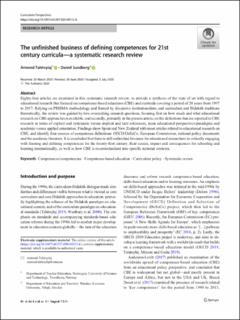| dc.contributor.author | Tahirsylaj, Armend | |
| dc.contributor.author | Sundberg, Daniel | |
| dc.date.accessioned | 2020-08-31T07:20:23Z | |
| dc.date.available | 2020-08-31T07:20:23Z | |
| dc.date.created | 2020-08-05T13:31:19Z | |
| dc.date.issued | 2020 | |
| dc.identifier.issn | 0159-7868 | |
| dc.identifier.uri | https://hdl.handle.net/11250/2675599 | |
| dc.description.abstract | Eighty-four articles are examined in this systematic research review, to provide a synthesis of the state of art with regard to educational research that focused on competence-based education (CBE) and curricula covering a period of 20 years from 1997 to 2017. Relying on PRISMA methodology and framed by discursive institutionalism, and curriculum and Didaktik traditions theoretically, the review was guided by two overarching research questions, focusing first on how much and what educational research on CBE approaches is available, and secondly, primarily in the present article, on the definitions that are reported in CBE research in terms of explicit and systematic versus implicit and tacit references, main educational perspectives/paradigms and academic versus applied orientation. Findings show Spain and New Zealand with most articles related to educational research on CBE, and identify four sources of competence definitions: OECD/DeSeCo, European Commission, national policy documents and the academic literature. It is concluded that there is still unfinished business for educational researchers in critically engaging with framing and defining competences for the twenty-first century, their causes, impact and consequences for schooling and learning internationally, as well as how CBE is recontextualised into specific national contexts. | en_US |
| dc.language.iso | eng | en_US |
| dc.publisher | Springer | en_US |
| dc.rights | Navngivelse 4.0 Internasjonal | * |
| dc.rights.uri | http://creativecommons.org/licenses/by/4.0/deed.no | * |
| dc.title | The unfinished business of defining competences for 21st century curricula—a systematic research review | en_US |
| dc.type | Peer reviewed | en_US |
| dc.type | Journal article | en_US |
| dc.description.version | publishedVersion | en_US |
| dc.source.journal | Curriculum Perspectives | en_US |
| dc.identifier.doi | https://doi.org/10.1007/s41297-020-00112-6 | |
| dc.identifier.cristin | 1821816 | |
| dc.description.localcode | This article is licensed under a Creative Commons Attribution 4.0 International License, which permits use, sharing, adaptation, distribution and reproduction in any medium or format, as long as you give appropriate credit to the original author(s) and the source, provide a link to the Creative Commons licence, and indicate if changes were made. The images or other third party material in this article are included in the article's Creative Commons licence, unless indicated otherwise in a credit line to the material. If material is not included in the article's Creative Commons licence and your intended use is not permitted by statutory regulation or exceeds the permitted use, you will need to obtain permission directly from the copyright holder. To view a copy of this licence, visit http://creativecommons.org/licenses/by/4.0/. | en_US |
| cristin.ispublished | true | |
| cristin.fulltext | original | |
| cristin.qualitycode | 1 | |

